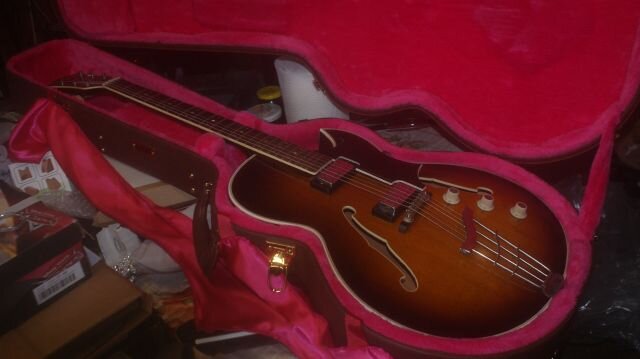-
Posts
1,254 -
Joined
-
Last visited
-
Days Won
231
Content Type
Profiles
Forums
Events
Shop
Everything posted by Dad3353
-
I totally agree with this; my Takamine is fitted with these ... ... I have 'etching fingers', which rapidly turn steel or nickel-steel strings to red rust; these 80/20 bronze strings suit the guitar perfectly, with the added advantage of being the same gauge as my electrics and semi-acoustics, all fitted with nano-web sets. They last, for me, much longer than any other make of strings; I previously had to change in less than a year, but these were fitted over a year ago now, and are as good as when fitted, although I admit that I don't play my acoustic every day. It's a joy when one finds the right set for any guitar or bass; I'd even extend this to establishing the best heads for an acoustic drum set..! I used Remo Ambassador heads for decades, but the later choice of Evans Genera and G2 heads made a world of difference..!
-
Good evening, @Matt_gtr76, and ... ... Plenty to read and amuse you here, and lots to learn and share.
-
Similar to this one..? Reverb ad ...
-
I found this after a web search ... I found my guitar's serial number by looking through the sound hole towards the fingerboard. The number is stamped on the neck block. Entering this number on this web site http://www.guitardating.com/takamine.php results in: Date Your Takamine The guitar was manufactured Sunday, December 14th, 1973. It was the 42nd guitar made that day. Have a look through the sound hole on yours, maybe..? Hope this helps.
-
This week, Thomann have this model, new, at £2070; why would I want a 2021 model..? You are, of course, aware that this one does not have a cutaway like the 314..? Does that matter to you at all..? Thomann have the 314 at just under £2000, new. Free delivery for either, I think.
-
Simple..? Did you say 'simple'..? Hm. My idea of 'simple' (my next birthday I'll be 75...) is a lead from the guitar straight into the amp..! As for your dilemma, my suggestion would be to buy the Tonex One, and either send it back after trials if it doesn't meet your needs, or keep it for a while longer, then decide to either sell it , or sell the Ampero if it has become redundant. No video demos or 'hype' will really show what choice is best; only your own set-up and playing style will do that. Be aware of the trap, of course, of trialling the thing, only to decide to keep both..! Does this help..? Douglas
-
Ah. For this, I'd refer you to my usual words of encouragement that I often dish out, when subjects such as this arise... 'It's the first forty years that are the worst, after which things sometimes tend to get slightly better.'
-
Learning to hear intervals can be accelerated muchly by starting from any one note (low 'E' for instance...), and counting out, from the scale, where the 'second' is (clue, it's F#...), then playing it, naming it out loud, and singing it. Do this, from the same low 'E', for all the other intervals : find the higher note from the scale, play it, name it and sing it. That won't take long at all; just a couple of minutes. Repeat, starting from another note (open 'A' string, for instance...), finding the interval from the 'A' major scale, play it, name it and sing it. Rinse and repeat, for as many starting notes as you wish. Doing this for a week or so, just in 'idle' time, will bring on a rapid appreciation of what these intervals sound like, in any key. It's a 'no-brainer', really, it's so easy and productive. You won't need to refresh this over time, as it becomes ingrained and automatic, very quickly. Hope this helps. Edit : to be really 'swish', one may continue beyond the octave and find/play/name/sing the extended intervals, 9th, 11th, 13th ...
-
When singing a melody through, in your head or out loud, try to pick out the highest and lowest notes, when you get to them. That's when to pick up the guitar and find those notes, and only those notes. That'll determine where on the fingerboard the rest of the melody lies, so, having established the extremes, now find the initial, starting note, keeping in mind these extremities. Does this help..?
-
Firstly (Good evening...), are we talking acoustic or electric guitar..? Any chance of a recording (a video with a 'phone should be enough, if it picks it up...), which would help enormously. Over to you...
-
If, as you say, it's minimal, I wouldn't worry about it at all. There are many guitars (even acoustics...) that are not symmetrically balanced anyway, so even if the wall mount was 'plumb', the weight could well be offset. I've never heard of a guitar neck being affected by being hung this way; they are pretty solidly constructed. If it's only an aesthetic thing, I'd leave it alone. It would be possible to redress things a little, without taking the wall mount down, by winding a piece of cloth onto one side of the mount, as packing, to have the guitar 'plumb'; I'd surely not bother. Hope this helps.
-
It's difficult to answer this, all the more so as it's your first guitar. I'd start off by suggesting that there's no real point in comparing the 'sound' of any guitar in this range; they are all good, and capable of producing quality 'tone', in many genres, once one knows how and what to play (plus pedals, amps, modelling etc...). So, listen to them, certainly, but that's not the important factor, really. What counts far more is how it feels and appeals to you. Is it comfortable (sitting and standing...)..? Do the controls seem easy to understand and use..? Does the neck feel good, when forming chords, or trying out solo runs or riffs..? Does it feel 'balanced' (you shouldn't have to hold the neck up with the fretting arm if it's got a decent strap on...). Look at the price, factoring in a hard case, or, at a minimum, a decent gig bag. If they have any other guitars in stock, take the time to give them all a decent try-out, too; it would be odd that they only have these two guitars on hand. Which one feels best, to you, whatever the shop folk say..? Ideally, give yourself a few days to reflect, and go back once you've decided; don't feel rushed to take one home that day (Yes, I know that that's a very difficult urge to resist..!). You can get just about any sound you want out of any guitars there, so it's a factor, but not the principle one. Hope this helps; let us know how it goes, maybe..?
-
Yes, 'triads' is a way of constructing chords, and is extremely useful. You already have a song repertoire far, far in excess of anything I've ever played in over half a century (disclaimer : I'm a drummer...), so 'Well done; you're doing something right..!' Can I recommend 'Guitar Pro 8'..? For the next couple of weeks it's at a reduced price of under £50, and is well worth it, in my opinion. As well as chord shape suggestions, it enables easy transposition and there are a wealth of songs in 'gp' format. Worth trying, maybe..?
-
It's an 'open secret' (one that so many people know, that they don't think it worth mentioning, so, to the non-initiated, it remains a secret..!) that, when playing guitar, one doesn't have to play all the strings, all the time, for all the chords. It's useful to practice, and so learn, only playing the strings that actually make up the chord (often only three or four...), and skip, or mute, the strings not needed. This applies to both open and barre chords, and even more so for 'movable' chords (where one may play them anywhere on the neck...). If a barre chord proves to be difficult, practice playing it further up the neck, where the first-finger barre may be easier, and gradually, every other day, move down towards the nut. The fingers will become more accustomed, and the barre easier. When barring a chord, try to get the sound right on only the top four strings, for instance, if the barre is difficult to manage right the way across. Then try again, but getting the bottom four strings to sound right (so not playing the top two...). You may also play without a barre at all if you play only the middle four strings (so not the top or bottom 'E' strings...), and compose the chord with the four fingers, without a barre at all. If these notions find resonance with you, I could compose a chord chart showing many ways of playing chords, with no barre, anywhere on the neck. Why does this matter..? Well, one reason is to be able to change chords easily by going across the neck, instead of up and down, making chord changes much smoother (and less tiring...). What songs or tunes do you presently play, and what songs or tunes would you like to play..? Any particular style, or guitarist, group or era..? It would help us to give more pertinent advice. Hope this helps. Douglas
-
I'd like to see a photo of these tuners. I'm assuming that they are not 'open', but enclosed in some kind of housing..? It's not possible for the shaft to turn the button. If that's happening with yours, then they are not 'worm-driven'. I don't see how the direct of rotation can be obtained without this mechanism. So I maintain that it is impossible to turn the button by string tension, however hard one tries. If, in turning the post, the button turns, there is something radically wrong with the mechanism, or it uses a completely different principle. A photo of these tuners would be helpful; what make of guitar is it..? I'm not sure, either, what your original Seller has or has not done. If one tuner has been changed, does it have this same bizarre effect..? Where do you live..? Is there not a decent guitar shop or guitar technician in the vicinity..? There is almost certainly a GuitarChat member not too far away that could have a look with more experienced eyes. Do nothing radical for now until the real issue has been established, at least, as there is, for the moment, a lot that seems odd. I understand that you may not be familiar with all the relevant terms; that's not a problem, and quite normal. The description so far, though, makes making helpful suggestions a little difficult. Patience; leave the claw hammer and chainsaw to one side until we get some more light on the problem. So.... Any chance of photos, of the guitar itself and these tricky tuners..?
-
I''m not sure that I'm fully understanding the issue, here. If it's the string tension making the tuning peg 'run backwards', to unwind, that makes little sense, to me. As you will have noticed, and your moped experience will confirm to you, a 'worm-driven axle' can only turn if the worm (endless gear...) turns. The axle cannot turn the the worm-drive. So, a guitar string can pull all it wants, it cannot make the 'button' turn. I can't understand how that could happen. One thing comes to mind, however... How are the strings being wound onto the tuning post..? The ideal wrap-around should be at least two, preferably three or four, wraps, and all neatly aligned, as in this photo ... There is a technique to stringing a guitar, and folk have differing preferences. Personally, I feed the 'free' end through the hole in the post, keeping the string taut by holding it above the fingerboard (about 10 cms...). I turn the button, and feed the string onto the bottom of the post for the first turn. As I continue to turn the button, I allow the string to cross this lowest turn, and continue wrapping, neatly, until all the slack has been taken up, and the string is now ready to be taken to pitch. There will be, usually, three or four turns on the post by this time, and it is impossible for the string to pull back, still less turn the post or button. Does this make sense to you..? Are you stringing up in this fashion..? If not, how do you go about it..? Over to you...
-
Good afternoon, @aljaxon, and ... ... Plenty to read and amuse you here, and lots to learn and share.
-
To better appreciate this event, I would refer you to a previous post here, where the 'back story' is quite fully related, so doesn't need repeating here. Skip it if you're in a hurry, but you'll be missing out. Soooooo... I've just, in the past few days, taken delivery of a new (to me, but not quite...) guitar that has been on my 'bucket list' for over half a century. A fellow member of our sister site (Basschat...) passed me a link to a site where this quite rare guitar was for sale, in Sweden. After looking up my finances (it was not cheap...), I contacted the Seller I 'bit the bullet', and, after some tractation over acquisition of a hard case for shipping, it finally arrived, safe and sound, snuggling up nicely in a brand new case. 'OK', I hear you ask, 'but what guitar is it..?' You'll have guessed if you'd read the post in the link above; it's a Hofner President Thinline E2 Florentine, from the late '60s, the same model that I foolishly 'let go' in my stoopid youth. Yippee..! Here's the photos I hastily took as it arrived... Pleased..? You betcha; pleased as Punch. I'm now struggling to get back to where I was, all those decades ago, trying to play a chord-melody version of 'Misty'. By a horrible coincidence, I had trimmed my nails, on both hands, and will have to wait a while before playing that way, as I have done since year 'dot', with only fingers, so I'm struggling at the same time with the use of a plectrum. It's all good, though, albeit extremely slow going. I have a Chromebook for displaying a Pdf of the version I'm using (from a Sandy Sherman YouTube video; just about the best and most accessible I've seen...), but as soon as I think I've assimilated a few bars, I turn the page to continue, but have forgotten it when I turn back again. I'm using my usual method of learning the 'outro' first, so that I'll be working into 'known' territory as I move forward, but, for now (it's been only a few days, but...) I'm finding it quite a job remembering only these dozen or so bars. It'll come (it has to..!), and I find the neck of this guitar to be exactly fitted to how I play (perhaps 'muscle memory' from all that time ago, when I learnt on that first President...). Anyway, enough rambling; back to the Chromebook for another session. I'll see about better pictures if/when the weather picks up, for outdoors lighting. Bye for now... Douglas
-
Good evening, Stephen, and ... ... Plenty to read and amuse you here, and lots to learn and share.
-
Does this help..? Note the 12/8 time signature, think Scottish jigs and reels when listening to it (Diddly, diddly, diddly, diddly...) Count, slowly, in groups of three (triplets...), such as 1-3,223,3-3,423, 1-3 223,3--,4-- where the dashes represent a note not played. Allow me to recommend Guitar Pro; it's very good.
-
Good evening, @Merkin2024, and ... ... Plenty to read and amuse you here, and lots to learn and share.
-
It's a non-issue. Off with the old, have a quick clean-up whilst the strings are off (toothbrush and lint-free cloth around the bridge, tuning pegs, frets...) and on with the new. Tune up to pitch and play on. The neck will be fine.









